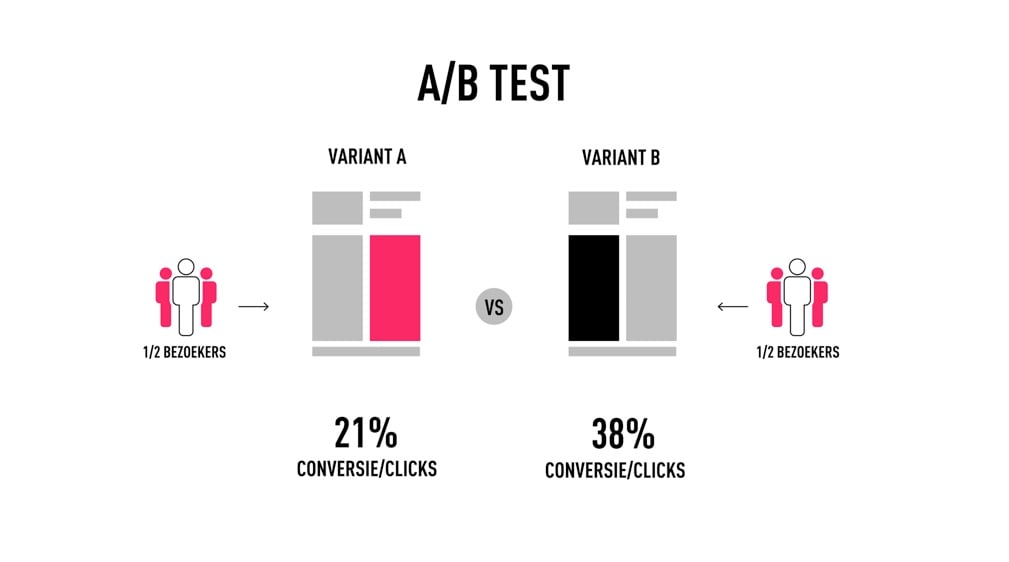With your website, you want something from visitors. That they download documents, apply for jobs or request quotes. When your website purposefully drives that, we call it conversion-enhancing web design. But how is this different from regular web design?
With the focus points below, you will make conversion-oriented web design possible. But many Internet agencies will not pay attention to this. In the final paragraphs, you’ll discover how to separate the wheat from the chaff and find the right partner.
Address the target audience with the right branding
Your target audience has its own pain points, problems and challenges. What is the unique value proposition your organization offers for this?
How you can help is one thing. But in a world where more and more products and services are beginning to look alike, the story you tell can be the deciding factor. So what is your history? What moves you? Why exactly should the customer choose you?
Branding is a marketing exercise that every organization should do before a new Web site comes up. In branding, you create a brand identity that attracts and holds the attention of your target audience. Download our branding checklist to see the extent to which your branding is in order.
Choose custom web design
The vast majority of Internet agencies work with ready-made themes. On an ongoing basis, they spit out websites that may look good, but feel suspiciously similar to other sites. You often see it right away when you browse through such a web builder’s portfolio.
Don’t get us wrong; there is nothing wrong with using a default theme. For bloggers and small businesses with little technical knowledge, such a solution is often fine. But (medium) sized companies and organizations, for whom the Internet plays an important role directly or indirectly, are better off with a customized solution.
Tailoring the design and layout precisely to your target audience helps optimize the conversion rate down to the last percentage points. In organizations operating on such a scale as yours, that can make a big difference in revenue or in the number of applicants.
Integrate your corporate identity
Branding goes hand in hand with a corporate identity: the logo, the colors, the font and the type of graphics you use. Also part of a corporate identity is a style guide, in which you give employees tips on how they should address visitors and customers.
By having your corporate identity reflected not only in your offline communications, but also online, you increase the recognizability of your organization, strengthen your image and generate trust with (potential) customers. Therefore, corporate identity is an important consideration when it comes to web design.
A serious Internet agency will ask for your corporate identity. If you do not have one, the agency will offer to prepare such an online corporate identity document. Often this exercise goes hand in hand with branding.
Focus on the customer journey: create funnels
If you want to achieve conversions through the website, directly or indirectly, visitors need to take a certain action. As specialists in converting websites, we keep such an action in mind when we design a website.
But it’s not that we want to knock visitors over the head with a call-to-action immediately upon entry. No, the key is to get on visitors’ radar via the know, like, trust principle. That takes patience and a genuine desire to add value.
Through the -familiar in the marketing world- funnel, visitors move almost imperceptibly toward the “spout” where conversion finally occurs. And what that conversion is, again, varies by organization. We’d love to hear what conversion goals you are pursuing.
Your goals should be S.M.A.R.T.
To increase the conversion rate of your website, it is important to set concrete and measurable goals. In marketing jargon, then, we often speak of SMART goals. This is an acronym for the characteristics such a goal should have:
- Specific– your goal must be specifically defined. What, how, who, why and when are some of the questions your objective should answer.
- Measurable. A goal that is not measurable, such as getting more website visitors, is not ambitious enough and can cause confusion. You want to cite concrete numbers so you can judge yourself on them.
- Attainableor achievable. This is mainly about making sure all the noses in your organization are pointing in the same direction. A goal may be logical and important in your eyes, but it’s of little use if your employees don’t see it that way.
- Relevant; also sometimes described in Dutch as realistic. Goals may well be ambitious, but they should not be so ambitious that they deter a priori. When starting a new project (such as a new site), it is best to begin with a modest goal and tighten it over time.
- Time-bound, or time-bound. What is the deadline for this goal? In what time period will you measure? By being specific about this, you avoid “cheating” and stretching time just to reach a certain conversion rate.
Also be sure to use the necessary tools to make your goals measurable. An absolute must for website owners is Google Analytics. That tool tells you who is visiting your site, with what devices and browsers, and how long they stay on which pages. Google Search Console helps you find pages that could use better optimization (SEO). Another tool that can be useful is Hotjar – thanks to heatmaps and A/B testing, you know how visitors experience your pages and what their preferences are.
Your web design is never finished: keep testing and measuring
For those serious about doing business online, a set-and-forget approach is disastrous. After all, the world of the Internet and Internet visitors is constantly changing. And your competitors are not sitting still either. A new web design, no matter how well it converts, does not guarantee success in six months, a year or three years.
To get the most out of your new website, it’s important to keep testing, measuring and optimizing things. Ideally, the same Internet agency will do that for you. After all, this person knows your organization pretty well and can actively think along with you.
Web design stands or falls with a good briefing
The success of your web design depends largely on the instructions you give an Internet agency. And that’s not something you communicate in a short email. You should take quite some time for this and reach internal agreement on your wishes and requirements. Then you draft a website briefing, a 10- to 20-page document that tells you more about your organization, your challenges and your expectations regarding a new website.
The starting point of a new website is therefore the briefing. Internally this provides a foothold and for the Internet agency it is also much more pleasant if there are clear agreements. Wondering how to write such a website brief and what it should contain? Read it here (template included).
Feel free to send the brief to multiple parties. One of the goals of the brief is to create a level playing field for Internet agencies so that they can come up with similar proposals. That makes choosing the right partner a lot easier.












